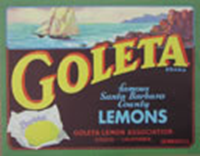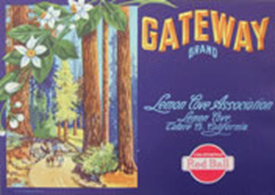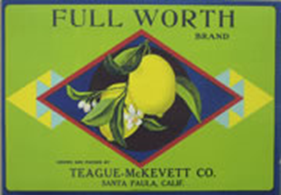 ER owns three citrus crate labels, and wonders if they’re valued as art or pieces of paper. The first label is recognizable—Goleta. We’ve all seen that on tea towels and posters. The second features our famous Redwoods, and the third a wonderful arresting graphic design. The colors catch the eye of loaders who packed crates on trains, and buyers. They’re more than art, in a way, because they say so much about food consumption and advertising. Some of the artists hired to create these labels worked directly from lithographic houses in our area.
ER owns three citrus crate labels, and wonders if they’re valued as art or pieces of paper. The first label is recognizable—Goleta. We’ve all seen that on tea towels and posters. The second features our famous Redwoods, and the third a wonderful arresting graphic design. The colors catch the eye of loaders who packed crates on trains, and buyers. They’re more than art, in a way, because they say so much about food consumption and advertising. Some of the artists hired to create these labels worked directly from lithographic houses in our area.
Commercial Graphic Designs of Historical Nature
 WHERE collections lives might define these unique treasures as works of art. These labels are considered valuable art and historical documents as evidenced by various museum and library collections of the genre. The Huntington collection comprises thousands of lithographed California citrus box labels, relating to the citrus industry 1880-1960. ER’s date from 1940-60.
WHERE collections lives might define these unique treasures as works of art. These labels are considered valuable art and historical documents as evidenced by various museum and library collections of the genre. The Huntington collection comprises thousands of lithographed California citrus box labels, relating to the citrus industry 1880-1960. ER’s date from 1940-60.
Southern California growers, packers, and distributors of brand names produced these labels for their wooden crates. Los Angeles and San Francisco lithographers, originating from the printers Western Lithograph Company, the Schmidt Lithograph Company, the Mutual Label & Lithograph Co printed the labels. A collection in curatorship resides at The Huntington Library, the Jay T. Last collection of food related ephemera. About this Last collection, and such vintage (original) labels in general, the online archive of California Finding Aid to The Huntington Library states:
“These labels conveyed important information about commercial printing, graphic design, and social history” (and) “touches on topics of commerce, manufacturing, travel, and tourism, as well as the promotion of the Western US. The images are promotional…providing information about the history of the citrus industry and their advertising. As graphic materials, the labels offer evidence of the development of printmaking, artists, lithographers, printers, and publishers. The labels depict citrus imagery, flowers, transport, farmers, fictional people.”
Other Collections of Citrus Crate Labels
The Corona Public Library also compiled a large collection of citrus crate labels collected by their staff from 1980-2004. This collection includes labels from all the major packing cases in Corona such as the Jameson Packing House, the Orange Heights Orange Association, and Foothill Lemon Company. The citation from the Corona public Library states: “fruit crate labels begin to be designed at the end of the 19th century. As refrigerated railroad cars helped make the long distance shipping of fruit possible, the industry developed labels so shippers and merchants could easily identify the crates. These vibrant, colorful paper labels pasted on boxes created a lively mobile advertisement.” Other institutions with citrus label collectors include Azusa Pacific University, Riverside Public Library and Tomas Rivera Library, UC Riverside.
Now we see that places that curate such labels consider them important to history, graphic design, industry, and fine art.
A narrow but active market, a book Fruit box Labels: An Illustrated Price Guide to Citrus Labels by Gordon T. McClelland and Jay T. Last, Hillcrest Press (1995) states prices paid in 1995.
Getting the Value of EF’s Citrus Crate Labels
 I selected eighteen labels from online sellers similar to those in the collection as per era and location of fruit (1950-60) as designed for Central Coast Californian Growers. Studying the comparable sales, I notice that certain images, such as the exotic and dramatically colored “Camel label,” sells for $70. But this seems an outlier as regards to prices asked in the category. Most of the labels sold on the market, are NOT expensive. Ninety percent of all comparable sales found offered between $8-$25 each label, as found on eBay, Etsy and Zazzle.
I selected eighteen labels from online sellers similar to those in the collection as per era and location of fruit (1950-60) as designed for Central Coast Californian Growers. Studying the comparable sales, I notice that certain images, such as the exotic and dramatically colored “Camel label,” sells for $70. But this seems an outlier as regards to prices asked in the category. Most of the labels sold on the market, are NOT expensive. Ninety percent of all comparable sales found offered between $8-$25 each label, as found on eBay, Etsy and Zazzle.
Few collectors exist, but objects with narrow appeal to only a few collectors means valeu to connoisseurs. If a fine condition label, with a great graphic, seems rare, and two collectors need that label, there’s no telling how much it might bring. The other factor with commercial material meant to be discarded, is that they WERE discarded. So brand name labels once produced in the thousands for years, is often rare today.
For this reason the jury remains out as per value of the three labels in EF’s collection. I will take a guess at the average price a NON-CONNOISSEUR will pay for these labels. If EF asked $75 for the three he might find a wiling buyer.